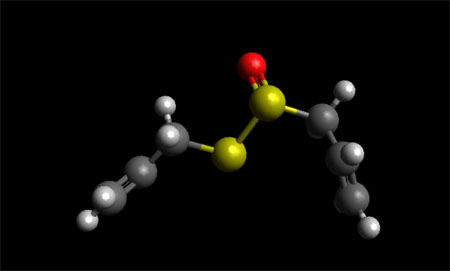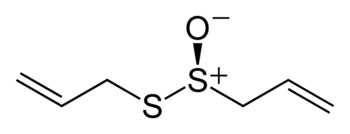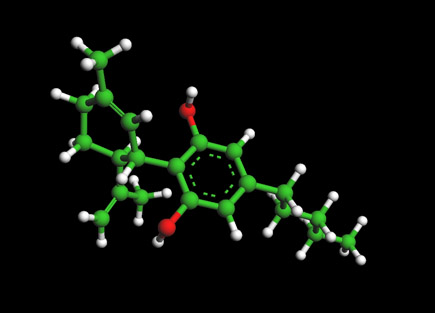Allicin--Anti-Aging and Senolytic Properties

Ball and Stick Model for Allinin Molecule
Allicin Molecule (above) Ball-and-stick. For 3D Jsmol File
Chemical formula-C6H10OS2
Molar Mass --- 162.26 g·mol−1
About Allicin
When fresh garlic is chopped or crushed, the enzyme alliinase converts alliin into allicin, which is responsible for the aroma of fresh garlic.The allicin generated is unstable and quickly changes into a series of other sulfur-containing compounds such as diallyl disulfide. Allicin is part of a defense mechanism against attacks by pests on the garlic plant. Allicin is an oily, slightly yellow liquid that gives garlic its unique odor. It is a thioester of sulfenic acid and is also known as allyl thiosulfinate. Its biological activity can be attributed to both its antioxidant activity and its reaction with thiol-containing proteins. Produced in garlic cells, allicin is released upon disruption, producing a potent characteristic scent when garlic is cut or cooked.
Allicin Molecular Structure

Overview of Allicin in Aging and Senescence
Numerous preclinical studies reported that organosulfur compounds from garlic could exert antioxidant, anti-inflammatory, antimicrobial, anticancer, and cardioprotective activities in various experimental settings.
Bioavailability of Allicin and search for Analogs
The bioavailability of allicin, the main active compound of garlic, from garlic supplements and garlic foods is highly questionable and unpredictable from in vitro tests, due to dependence upon alliinase activity under conditions that challenge alliinase activity (heat, gastric acid, intestinal proteases). It is likely that garlic supplement manufacturing procedures and coatings, meal conditions when supplements are consumed (high or low protein), and garlic food preparation conditions (temperature, surface area) will greatly affect allicin bioavailability. Such variability may account for some of the many conflicts seen in clinical trials on cardiovascular disease risk factors. see abstract below....Allicin Bioavalability and ...for most recent data.
Abstracts:
24 June 2018 -- Allicin Bioavailability and Bioequivalence from Garlic Supplements and Garlic Foods
Allicin is considered responsible for most of the pharmacological activity of crushed raw garlic cloves. However, when garlic supplements and garlic foods are consumed, allicin bioavailability or bioequivalence (ABB) has been unknown and in question because allicin formation from alliin and garlic alliinase usually occurs after consumption, under enzyme-inhibiting gastrointestinal conditions. The ABB from 13 garlic supplements and 9 garlic foods was determined by bioassay for 13 subjects by comparing the area under the 32-h concentration curve of breath allyl methyl sulfide (AMS), the main breath metabolite of allicin, to the area found after consuming a control (100% ABB) of known allicin content: homogenized raw garlic. For enteric tablets, ABB varied from 36–104%, but it was reduced to 22–57% when consumed with a high-protein meal, due to slower gastric emptying. Independent of meal type, non-enteric tablets gave high ABB (80–111%), while garlic powder capsules gave 26–109%. Kwai garlic powder tablets, which have been used in a large number of clinical trials, gave 80% ABB, validating it as representing raw garlic in those trials. ABB did not vary with alliinase activity, indicating that only a minimum level of activity is required. Enteric tablets (high-protein meal) disintegrated slower in women than men. The ABB of supplements was compared to that predicted in vitro by the dissolution test in the United States Pharmacopeia (USP); only partial agreement was found. Cooked or acidified garlic foods, which have no alliinase activity, gave higher ABB than expected: boiled (16%), roasted (30%), pickled (19%), and acid-minced (66%). Black garlic gave 5%. The mechanism for the higher than expected ABB for alliinase-inhibited garlic was explored; the results for an alliin-free/allicin-free extract indicate a partial role for the enhanced metabolism of γ-glutamyl S-allylcysteine and S-allylcysteine to AMS. In conclusion, these largely unexpected results (lower ABB for enteric tablets and higher ABB for all other products) provide guidelines for the qualities of garlic products to be used in future clinical trials and new standards for manufacturers of garlic powder supplements. They also give the consumer an awareness of how garlic foods might compare to the garlic powder supplements used to establish any allicin-related health benefit of garlic. Keywords: allicin bioavailability, allicin metabolism, allyl methyl sulfide, alliin, S-allylcysteine, garlic supplements, cooked garlic, pickled garlic, black garlic, aged garlic extract. see full publication
21 September 2019--Allicin alleviates lead-induced hematopoietic stem cell aging by up-regulating PKM2
The research and development of pharmaceutical intervention is insufficient for the frail older adults, especially in preclinical stage for the frail individuals with osteoporosis. Garlic exerts an antiosteoporotic effect and its vital component allicin could protect organisms against aging. The present study aimed to investigate the effect of long-term intragastric administration of allicin (low dose of 4 mg·kg−1·d−1; middle dose of 8 mg·kg−1·d−1; high dose of 16 mg·kg−1·d−1) on frailty with osteoporosis in aging male Fischer 344 rats. Frailty was assessed with a 27-item frailty index based on quantifying health-related deficits in adult male rats varied from 13 to 21 months and in control rats from 6 to 9 months. Osteoporosis was appraised by bone mineral density detected by dual-energy X-ray absorptiometry, biomechanical properties measured by a three-point bending test, and bone metabolic analysis using ELISA. Allicin could attenuate frailty index scores by reducing the accumulation of health deficits in aging male Fischer 344 rats. Meanwhile, allicin could protect against senile osteoporosis, and the underlying mechanism may involve in increasing low bone turnover through elevation of both bone formation and bone resorption, and subsequently lead to increase of bone mineral density, contributing to reversing deleterious bone biomechanical features associated with aging. The present study reveals firstly that long-term oral administration with allicin attenuated frailty with osteoporosis during the process of aging, which provides a preclinical evidence for intervention of frailty. see full publication
19 April 2015 -- Immunomodulation and Anti-Inflammatory Effects of Garlic Compounds
The benefits of garlic to health have been proclaimed for centuries; however, only recently have Allium sativum and its derivatives been proposed as promising candidates for maintaining the homeostasis of the immune system. The complex biochemistry of garlic makes it possible for variations in processing to yield different preparations with differences in final composition and compound proportion. In this review, we assess the most recent experimental results, which indicate that garlic appears to enhance the functioning of the immune system by stimulating certain cell types, such as macrophages, lymphocytes, natural killer (NK) cells, dendritic cells, and eosinophils, by mechanisms including modulation of cytokine secretion, immunoglobulin production, phagocytosis, and macrophage activation. Finally, because immune dysfunction plays an important role in the development and progress of several diseases, we critically examined immunoregulation by garlic extracts and compounds isolated, which can contribute to the treatment and prevention of pathologies such as obesity, metabolic syndrome, cardiovascular disorders, gastric ulcer, and even cancer. We concluded that A. sativum modulates cytokine secretion and that such modulation may provide a mechanism of action for many of their therapeutic effects. see full publication
9 March 2012 -- The Antioxidant Mechanisms Underlying the Aged Garlic Extract- and S-Allylcysteine-Induced Protection
Aged garlic extract (AGE) is an odorless garlic preparation containing S-allylcysteine (SAC) as its most abundant compound. A large number of studies have demonstrated the antioxidant activity of AGE and SAC in both in vivo—in diverse experimental animal models associated to oxidative stress—and in vitro conditions—using several methods to scavenge reactive oxygen species or to induce oxidative damage. Derived from these experiments, the protective effects of AGE and SAC have been associated with the prevention or amelioration of oxidative stress. In this work, we reviewed different antioxidant mechanisms (scavenging of free radicals and prooxidant species, induction of antioxidant enzymes, activation of Nrf2 factor, inhibition of prooxidant enzymes, and chelating effects) involved in the protective actions of AGE and SAC, thereby emphasizing their potential use as therapeutic agents. In addition, we highlight the ability of SAC to activate Nrf2 factor—a master regulator of the cellular redox state. Here, we include original data showing the ability of SAC to activate Nrf2 factor in cerebral cortex. Therefore, we conclude that the therapeutic properties of these molecules comprise cellular and molecular mechanisms at different levels. see full publication
4 Jan 2017 --Aged garlic has more potent antiglycation and antioxidant properties compared to fresh garlic extract in vitro
Protein glycation involves formation of early (Amadori) and late advanced glycation endproducts (AGEs) together with free radicals via autoxidation of glucose and Amadori products. Glycation and increased free radical activity underlie the pathogenesis of diabetic complications. This study investigated whether aged garlic has more potent antiglycation and antioxidant properties compared to fresh garlic extract in vitro in a cell-free system. Proteins were glycated by incubation with sugars (glucose, methylglyoxal or ribose) ±5–15 mg/mL of aged and fresh garlic extracts. Advanced glycation endproducts were measured using SDS-PAGE gels and by ELISA whereas Amadori products were assessed by the fructosamine method. Colorimetric methods were used to assess antioxidant activity, free radical scavenging capacity, protein-bound carbonyl groups, thiol groups and metal chelation activities in addition to phenolic, total flavonoid and flavonol content of aged and fresh garlic extracts. Aged garlic inhibited AGEs by 56.4% compared to 33.5% for an equivalent concentration of fresh garlic extract. Similarly, aged garlic had a higher total phenolic content (129 ± 1.8 mg/g) compared to fresh garlic extract (56 ± 1.2 mg/g). Aged garlic has more potent antiglycation and antioxidant properties compared to fresh garlic extract and is more suitable for use in future in vivo studies. see full publication
Anti-Aging and Senolytics Home Page
- What is Anti-Aging Medicine
- What is Senescence?
- What are Senolytics?
- About Caloric Restriction
- Mtor and Rapamycin
- The IKK/NF-κB signaling pathway in aging
- Exercise and Anti-Aging
- Meditation and Anti-Aging
SENOLYTIC AND ANTI-AGING MOLECULES
RAPAMYCIN ---The mechanistic target of rapamycin (mTOR) pathway has a central role in cell activation...
METFORMIN -- The diabetes drug metformin used by some for anti-aging may diminish benefits of aerobic exercise...
QUERCETIN-- AND WITH DASATINIB--The senolytic cocktail, dasatinib plus quercetin, which causes selective elimination of senescent cells...
FISETIN--Of the 10 flavonoids tested, fisetin was the most potent senolytic...
EGCG- The most active component of green tea....
NAD BOOSTERS --'...The cells of the old mice were indistinguishable from the young mice, after just one week of treatment...
SULFORAPHANE-- An isothiocyanate present in cruciferous vegetables activates antioxidant and anti-inflammatory responses by ...
UROLITHIN --Metabolite of Pomegranate compound with anti-aging effects passes human trial...
MITO-Q -- A water soluble fomr of CoQ10 that has excellent absorption and high bioavailability...
HONOKIOL - A bioactive natural product derived from Magnolia Bark have demonstrated ...
CURCUMIN AND ANALOGS -Recent research is focused on the design and synthesis of curcumin analogs as antiproliferative and anti-inflammatory agents...
BERBERINE --berberine has recently been reported to expand life span in Drosophila melanogaster, and attenuate premature cellular senescence
N-ACETYL-CYSTINE (NAC)--"...pretreatment with NAC increased glutathione levels in the older cells and largely helped offset that level of cell death..."
PIPERLONGUMINE - A natural product from the Long pepper with high bioavailability...
RESVERATROL AND PTEROTSILBINE -- Pterostilben chemically similar to resveratrol bute differs from resveratrol by exhibiting increased bioavailability (80% compared to 20% in resveratrol)
SPERMIDINE--Spermidine delays aging in humans ...
ALLICIN -- Allicin is a compound produced when garlic is crushed or chopped. ...
VITAMIN D3 -- Production of the active forms of Vitamin D are reduced by 50% as a result of an age-related decline
VITAMIN K-- evidence suggests vitamin K has an anti-inflammatory action
TOCOTRIENOL(AND WITH QUERCETIN) --Tocotrieniols have been found to exert a synergistic antitumor effect on cancer cells when given in combination....
HSP-90 INHIBITORS --As a novel class of senolytics
The Cannabidiol Molecule
Cannabidiol (CBD is the major non-psychoactive component of Cannabis and is being looked at by major drug and consumer companies for various medical and social uses.